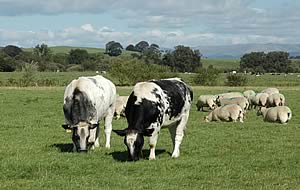| 2009-08-16
Liver fluke is already affecting large numbers of grazing cattle and sheep across the country this season and needs urgent autumn management attention if losses are to be minimised, warns EBLEX, the industry body for beef and lamb levy-payers in England.
Meat Hygiene Service records showing relatively high infection levels are confirmed by abattoirs having to reject over 50% of cattle livers for fluke in many cases. And a number of producers are receiving slaughter reports of infected stock for the first time ever.
The current threat posed by liver fluke is highlighted in the latest monthly forecast from the National Animal Disease Information Service (NADIS) which predicts a high to very high prevalence of disease across all parts of England except the south and east as well as Wales, Scotland and Northern Ireland over the autumn if wet conditions persist.
The NADIS forecast – with regular updates available at www.nadis.org.uk – clearly attributes this year’s particularly high fluke risk to the third wet summer in a row, pointing out that the high levels of infection recorded in 2008 and the very wet snail-friendly conditions of last autumn will have meant large numbers of infected snails over-wintering.
While a dry August tends to limit numbers of infective fluke on pastures, current weather expectations suggest many parts of the country could well see severe epidemics of acute clinical disease from the start of September with lower risk areas seeing significant disease from early October.
Under these conditions and with fluke causing sudden death in ewes and lambs and performance losses averaging £20-25/head in beef animals, EBLEX suggests an early start to fluke treatment will be advisable for many, with advice from a vet about the most suitable choice of product.
Treating sheep flocks in higher risk areas in September rather than October, as may be traditional, could be worthwhile this year with a second dose given around 6 weeks later even in flocks that have no previous history of problems. Repeat treatments in winter and spring may also be necessary. Post-mortem examination of sudden deaths are valuable to confirm infection.
Cattle that have grazed high risk autumn pastures should be dosed 7-14 days after housing with a flukicide effective against both immature and adult fluke. Out-wintered stock in some areas may require additional doses of flukicide if wet conditions persist, including a spring treatment against adult fluke to reduce the shedding of eggs to infect snails over the subsequent summer.
Practical management guidance to help livestock producers combat liver fluke is available free of charge to English levy payers in special Beef and Lamb Action for Profit fact sheets – Better Returns by Controlling Liver Fluke – with additional information in the Beef Diseases Directory. These publications can be obtained through www.eblex.org.uk.
 Global Drive Launched Against FMD Global Drive Launched Against FMD
 Cattle Tuberculosis Confirmed in Texas Cattle Tuberculosis Confirmed in Texas
 Protect Finishing Lambs from Clostridia and Pasteurella Threat Protect Finishing Lambs from Clostridia and Pasteurella Threat
|



